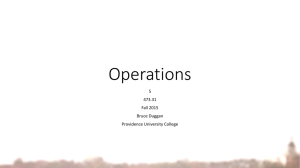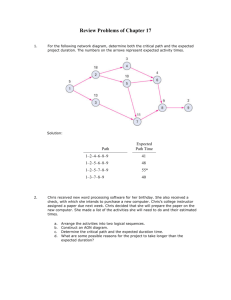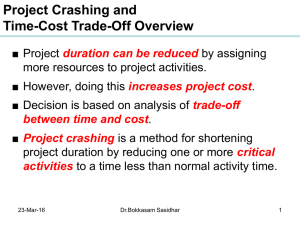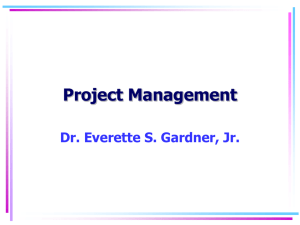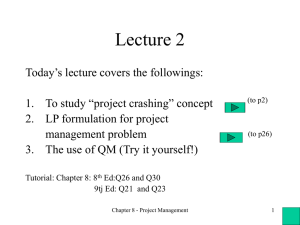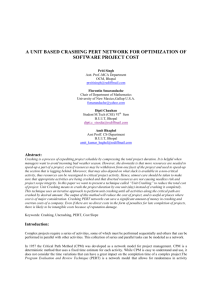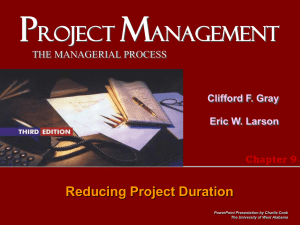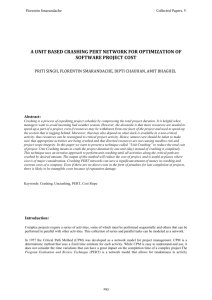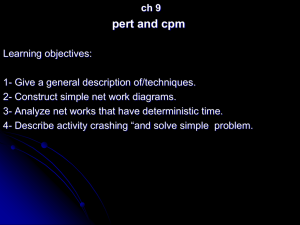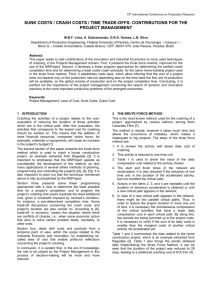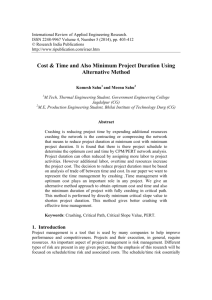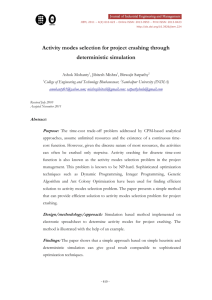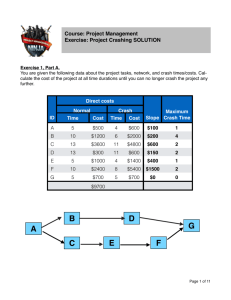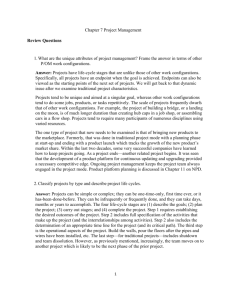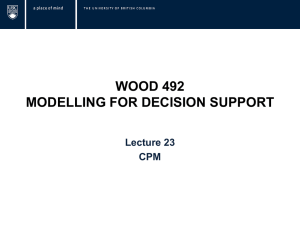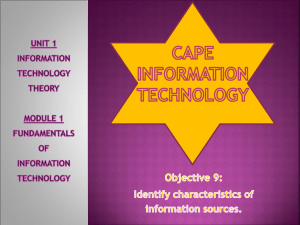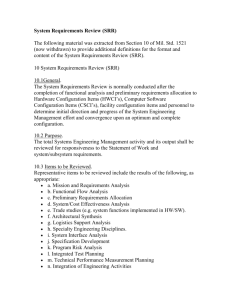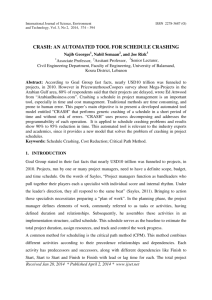TE3E1 - Pomsmeetings.org
advertisement
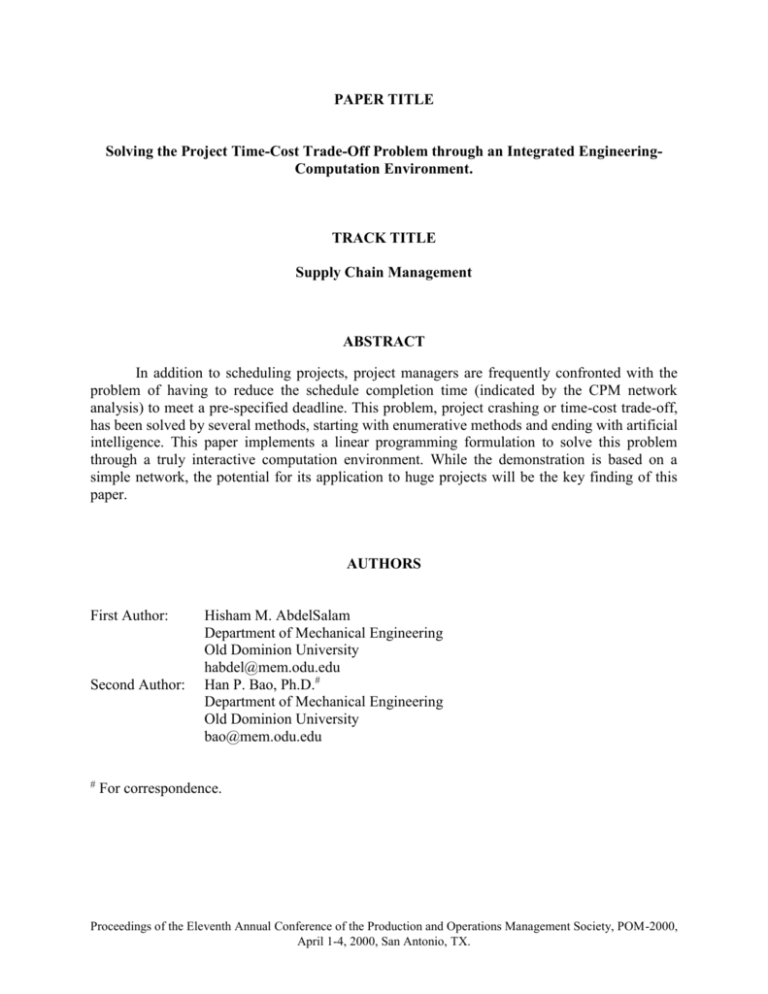
PAPER TITLE Solving the Project Time-Cost Trade-Off Problem through an Integrated EngineeringComputation Environment. TRACK TITLE Supply Chain Management ABSTRACT In addition to scheduling projects, project managers are frequently confronted with the problem of having to reduce the schedule completion time (indicated by the CPM network analysis) to meet a pre-specified deadline. This problem, project crashing or time-cost trade-off, has been solved by several methods, starting with enumerative methods and ending with artificial intelligence. This paper implements a linear programming formulation to solve this problem through a truly interactive computation environment. While the demonstration is based on a simple network, the potential for its application to huge projects will be the key finding of this paper. AUTHORS First Author: Second Author: # Hisham M. AbdelSalam Department of Mechanical Engineering Old Dominion University habdel@mem.odu.edu Han P. Bao, Ph.D.# Department of Mechanical Engineering Old Dominion University bao@mem.odu.edu For correspondence. Proceedings of the Eleventh Annual Conference of the Production and Operations Management Society, POM-2000, April 1-4, 2000, San Antonio, TX. INTRODUCTION The Time-Cost Trade-Off problem aims at reducing the overall completion time of a project by ‘crashing’, i.e. reducing the time of a number of tasks in the project while holding the total cost of the project to a minimum. This problem has been solved by several methods over the last two decades. At the beginning, people used an enumerative method, by which the project length can be reduced by reducing the duration of the critical activities. Although it is direct, several difficulties were faced when using such a method; 1) the critical path of the project may change once we start crashing the critical activities, 2) inapplicable to large projects, and 3) time consuming. In order to handle these difficulties, people have used mathematical programming methods (Linear programming, Integer programming, and Nonlinear programming) which proved to be more efficient in determining the optimal project schedule. But still, in large projects, mathematical programming remains time-consuming, and may be inapplicable. Another approach was using heuristic algorithms and artificial intelligence. These methods although faster, usually do not give an optimal solution, but rather a near optimal solution only. Nowadays, the computing world has witnessed a new generation of PCs with very high computational speed, beside the emerging of new, and most capable optimization software. Using these software has enabled us to handle the time-cost trade-off problem in large projects as a mathematical programming problem and then solve it. So, we can combine both optimality and speed. PROJECT CRASHING WITH LINEAR PROGRAMMING As discussed in Render and Stair (1991), Taylor (1996), Phillips et. al. (1976), and Williams (1999), both CPM/PERT network and project crashing network can be formulated as a linear programming problem; “to minimize the cost of crashing given the limits on how much individual activities can be crashed.” Cost Model Assumptions 1. Activity duration’s are independent of each other; 2. Cost functions are linear and independent. The cost of crashing of one activity does not change whether or not some other activity is also crashed; 3. The variances of costs and time are not important, and can be neglected; and 4. Variations in the overall requirements for resources do not affect the project cost. THE PROPOSED FRAMEWORK The framework, shown in figure (1), integrates the capabilities of two commercial software, Microsoft ExcelTM (spreadsheet), and Microsoft ProjectTM (project management), with a state-of-the-art Adaptive Knowledge Network (AKN), InnerCircle2000TM, to solve the mentioned problem interactively. The AKN provides: 1. A storing media through an active object-oriented database, 2. Application integration through several Active-X linkages with Microsoft ExcelTM and Microsoft ProjectTM, and 3. Functional integration (design, analysis, optimization, etc.) environment. The framework acts as follows. An object-oriented database model representing the project work break-down structure will be created. Through the AKN linkages; First, the required resources for each activity are to be determined and stored in the database, second, the project time chart will be drawn and resource analysis is to be performed, third, project network crashing and timecost trade-off analysis are to be done allowing the decision-maker to choose the best time span to Proceedings of the Eleventh Annual Conference of the Production and Operations Management Society, POM-2000, April 1-4, 2000, San Antonio, TX. execute the project, and finally, the crashed project time chart will be drawn in a separate file allowing new resource analysis to take place. In order to perform crashing analysis, a linear programming model of the network is applied and solved with an Excel Add-in (Solver). DEMONSTRATION Figure (2) shows the assumed linear relation between activity cost and activity duration. Figure (3) shows a network representing some project, and the normal activities are shown on it. Performing the usual CPM analysis results in the critical path being 1-2-3-4-6-7, and the Project Completion Time (PCT) being 36 weeks. Figure (4) shows the project data entry spreadsheet, while Figure (5) demonstrates the Time-Cost Trade-Off calculations performed in a spreadsheet. And finally, figure (6) demonstrates the Time-Cost Trade-Off curve as drawn by Excel. DISCUSSION AND CONCLUSION The capabilities of object-oriented databases make them suitable for handling complicated engineering projects, where the amount of information stored in the database is huge, and the connections among this information are complex. The presented framework demonstrates the role that an active object-oriented database can play in providing a flexible environment that enables decision-makers to explore the project before committing scarce resources. REFERENCES Taylor III, B. W.. Introduction to Management Science (5th ed.). Prentice Hall, NJ, 1996. Williams, H. P.. Model Building in Mathematical Programming (4th ed.). John Wiley & Sons, LTD, NY, 1999. Render, B., and R. M. Stair. Introduction to Management Science. Allyn & Bacon, Massachusetts, 1991. Phillips, D. T., A. Ravindran, and J. J. Solberg. Operations Research: Principles and Practice. John Wiley & Sons, LTD, NY, 1976. Figure (1). The Proposed Framework Proceedings of the Eleventh Annual Conference of the Production and Operations Management Society, POM-2000, April 1-4, 2000, San Antonio, TX. Activity Cost Crashed Activity C (C. Cost-N. Cost) Slope = (N. Time-C. Time) N Normal Activity C N Activity Duration Figure (3):Project Network Figure (2): Cost Model Figure (4): Project Data Entry Table Figure (5): Time-Cost Trade-Off Spread Sheet Crashing Cost 35000 Crashing Cost 30000 25000 20000 15000 10000 5000 0 35 34 33 32 31 30 29 28 27 26 25 24 23 Project Completion Time Figure (6): Time-Cost Trade-Off Curve Proceedings of the Eleventh Annual Conference of the Production and Operations Management Society, POM-2000, April 1-4, 2000, San Antonio, TX.
